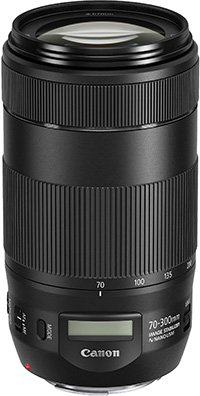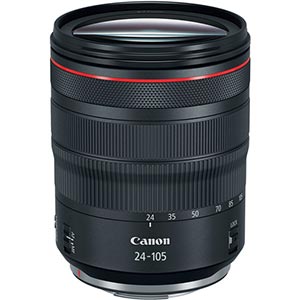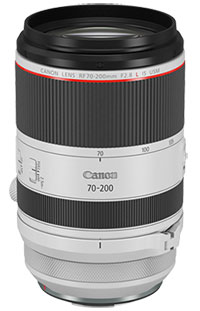List of Canon Nano USM Lenses
I was unable to find a list of Canon’s Nano USM lenses, so I thought I would create one. Nano USM (ultrasonic motor) is Canon’s latest generation of lens motors, combining the speed of USM motors with the silent action of their STM motors. If you’ve heard news of a new Nano USM lens and I haven’t listed it, please let me know below.
Lenses which have the Nano USM
- EF-S 18-135mm f/3.5-5.6 IS USM
- EF 70-300mm f/4-5.6 IS II USM
- RF 24-105 F4L IS USM
- RF 24-240 f4-6.3 IS USM
- RF 70-200mm F2.8 L IS USM
- RF 15-35mm F2.8 L IS USM
- RF 24-70mm F2.8 L IS USM
- RF 70-200mm F4 L IS USM
See further below for a Nano USM vs STM video comparison and some history on Nano USM lenses.
EF-S 18-135mm f/3.5-5.6 IS USM

Canon EF-S 18-135mm IS USM
Pricing
The Canon 18-135mm IS USM was released in March, 2016, as the improved version of the previous Canon 18-135mm IS STM lens. Generally regarded as an upgrade to the normal 18-55mm IS STM kit lens, the 18-135mm IS USM features the new Nano USM as well as the ability to be used with the Canon PZ-E1 zoom adapter. This lens has received generally positive feedback for being an “all-rounder”, especially for those looking to get into DSLR video-making. Note that this lens has an EF-S mount, meaning it will work on Canon APS-C cameras, but not full frame ones.
Specifications
- Focal range: 18-135mm
- Aperture range: f/3.5-5.6
- Mount: EF-S (APS-C)
- Image stabilisation: Yes
- Motor: Nano USM
- Weight: 515g
- Released: March 2016
- Official page: Canon EF-S 18-135mm IS USM
EF 70-300mm f/4-5.6 IS II USM

Canon EF 70-300mm f/4-5.6 IS II USM
Pricing
The Canon 70-300mm ISM II USM was released in September, 2016, replacing the previous version, the 70-300mm f/4-5.6 IS USM lens. Unlike most other lenses, the Nano USM version of the 70-300mm has an LCD screen, which provides the user various information about the shooting environment. Such factors include:
- Focusing distance
- Focal length
- Camera shake amount
as well as having the ability to reverse its black and white display pixels depending on the user’s preference. Note that this lens has an EF mount, meaning it will work on both APS-C and full frame cameras by Canon.
Specifications
- Focal range: 70-300mm
- Aperture range: f/4-5.6
- Mount: EF (Full frame and APS-C)
- Image stabilisation: Yes
- Motor: Nano USM
- Weight: 710g
- Released: September 2016
- Official page: Canon EF 70-300mm f/4-5.6 IS II USM
RF 24-105 F4L IS USM

Canon RF 24-105mm IS USM
Pricing
Announced in September 2018, the RF 24-105mm features the Nano USM autofocus motor. The lens is designed in-part for videographers, with a constant f/4 aperture that can be controlled in 1/8th EV steps, image stabilisation and minimal focus breathing.
The lens features Canon’s new RF mount, debuting on its first full-frame mirrorless camera, the Canon EOS R.
Specifications
- Focal range: 24-105mm
- Aperture: f/4
- Mount: RF
- Image stabilisation: Yes
- Motor: Nano USM
- Weight: 700g
- Released: September 2018
- Official page: Canon RF 24-105mm f/4 IS USM
RF 24-240mm f4-6.3 IS USM Lens

RF 24-240mm f4-6.3 IS USM
Pricing
Designed to be more of an “all-in-one”, “superzoom” lens, or something that will come in a kit, the RF 24-240mm f4-6.3 IS USM represents more of an affordable option in the current RF lens line-up. With image stabilisation and de-clicked aperture blades, the RF 24-240 appears to be aimed at video-makers.
Specifications
- Focal range: 24-240mm
- Aperture: f/4-6.3
- Mount: RF
- Filter size: 72mm
- Image stabilisation: Yes (5 stops)
- Motor: Nano USM
- Weight: 750g
- Released: September 2019
- Official page: Canon RF 24-240mm f4-6.3 IS USM
RF 70-200mm F2.8 L IS USM

Canon RF 70-200mm F2.8 L IS USM
Pricing
The Canon RF 70-200mm F2.8 L IS USM was the first Canon lens to feature two Nano USM motors. Canon’s EF 70-200 lenses have historically been the ones that many photographers will build the rest of their kit around, due to the constant wide aperture, large range and excellent optical quality. One major difference from its predecessors, however, is it’s smaller length, achieved by introducing an extendible
Specifications
- Focal range: 70-200mm
- Aperture: f/2.8
- Mount: RF
- Image stabilisation: Yes
- Motor: Nano USM (x2)
- Weight: 1070g (without tripod mount)
- Released:
- Official page: Canon RF 70-200mm F2.8 L IS USM
RF 15-35mm F2.8 L IS USM

RF 15-35mm F2.8 L IS USM
Pricing
Specifications
- Focal range: 15-35mm
- Aperture range: f/2.8
- Mount: RF
- Image stabilisation: Yes (5 stops)
- Motor: Nano USM
- Weight: 840g
- Released:
- Official page: Canon RF 15-35mm F2.8 L IS USM
RF 24-70mm F2.8 L IS USM

RF 24-70mm F2.8 L IS USM
Pricing
Specifications
- Focal range: 24-70mm
- Aperture range: f/2.8
- Mount: RF
- Image stabilisation: Yes (5 stops)
- Motor: Nano USM
- Weight: 900g
- Released:
- Official page: Canon RF 24-70mm F2.8 L IS USM
RF 70-200mm F4 L IS USM
Information on the RF 70-200mm F4 L IS USM will be published at a later date.
Pricing
TBA
Specifications
- Focal range: 70-200mm
- Aperture range: f/4
- Mount: RF
- Image stabilisation: Yes (5-7.5 stops, depending on camera)
- Motor: Nano USM
- Weight: 695g
- Released:
- Official page: Canon RF 70-200mm F4 L IS USM
Nano USM Lenses Background Information
Canon USM vs Canon STM Speed
Canon produced a quick video which demonstrates how fast the Nano USM auto-focus speed is versus the STM motor in the 18-135mm lens.
It would be interesting to see the difference in other Nano USM lenses.
History of Nano USM Development
Nano USM was developed as a challenge for Canon to combine the auto-focus speed of its USM motors with the quiet action of its STM motors. The motor itself is surprisingly small, and works using vibration along the length of the lens to extend or contract the focusing elements. The official video below shows more about how this works:
Supported Auto-Focus Systems
Only certain Canon cameras work with Nano USM lenses for its intended smooth video performance. These cameras include those with Canon’s Hybrid AF or Dual-Pixel AF systems.
More information
For more information about Canon’s Nano USM lenses, check out the following links:
- STM vs USM Lenses
- What’s New: Nano USM – A New Ultrasonic Motor Technology, by Rudy Wintson at Canon

Comments